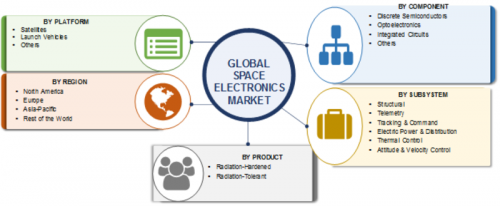Space Electronics Market Worldwide Overview and Forecast to 2023 With Regional Trends and Competitive Landscape By Global Leaders
Space Electronics Market Research Report 2019-2023: Industry Size, Share, Trends, Growth, Sales, Revenue, Risk and Opportunity Assessment with Regional Analysis and Segmentation By Platform (Satellites & Launch Vehicles), Component (Optoelectronics & Integrated Circuits), Subsystem (Structural & Telemetry), Product (Hardened & Tolerant) & Region

Pune , India – September 30, 2019 /MarketersMedia/ —
Space Electronics Market To Expand at a Notable CAGR Of 6.53% During 2018 – 2023. The space industry is an ecosystem of businesses and academia that rely on space-based technologies and data. Increasing investments by various governments in space projects are propelling market growth. However, the harsh environmental conditions faced by spacecraft such as extreme temperatures and a significantly increased threat of radiation damage pose a serious challenge to market players.
New and existing players in the Space Electronics Market are expected to see sizable growth during the forecast period. Increase in the production of satellites and the growing entry of commercial space companies are contributing to the demand for electronics in the space industry.
The key players in the global space electronics market are BAE Systems PLC (UK), Cobham PLC (UK), Heico Corporation (US), Honeywell International Inc. (US), Microsemi Corporation (US), ON Semiconductor (US), ST Microelectronics NV (Switzerland), Texas Instruments (US), Teledyne e2v (UK), TT Electronics PLC (UK), and Xilinx Inc. (US).
Get a FREE Report Sample with Complete TOC @ https://www.marketresearchfuture.com/sample_request/7584
Based on component type, the global space electronics market has been segmented into discrete semiconductors, optoelectronics, integrated circuits, and others. The integrated circuits segment is expected to be the largest during the forecast period of 2018 to 2023. Increasing demand for electronics with reduced SWaP is driving the growth of the segment.
Based on product type, the global space electronics market has been classified as radiation-hardened electronics and radiation-tolerant electronics. The radiation-tolerant segment is likely to witness a higher growth rate during the forecast period due to the increasing demand for commercial-off-the-shelf (COTS) components, drastically lower launch costs by commercial space companies, and the growing demand for small satellites, especially for earth observation, communication, and networking applications.
The global space electronics market has been categorized, by subsystem, as structural, telemetry, tracking and command, electric power and distribution, thermal control, and the attitude and velocity control. The structural subsystem segment is expected to be the largest during the forecast period. The components of an attitude and velocity control system include sun and Earth sensors, star sensors, momentum wheels, inertial measurement units (IMUs), and the electronics required to process signals and control satellite position.
Based on region, the global space electronics market has been segmented into North America, Europe, Asia-Pacific, and the rest of the world. As per the report, North America is expected to be the largest and fastest-growing space electronics market during the forecast period.
Intended Audience
• Satellite manufacturers
• Space organizations
• Government authorities
• Defense companies
• Research institutes
• Regulatory bodies
Research Methodology
The market values and forecast are derived using the MRFR research methodology, which includes secondary research, primary interviews, data triangulation and validation from an in-house data repository, and statistical modeling tools.
Secondary Research
In this process, data is collected from various secondary sources, including annual reports, SEC filings, journals, government associations, aerospace & defense magazines, white papers, corporate presentations, company websites, and paid databases, among others.
Primary Research
In this process, both the demand- and supply-side parties are interviewed to extract facts and insights about the market forecast, production, trends, and projected market growth. Industry stakeholders such as CEOs, VPs, directors, and marketing executives across the value chain are approached to obtain key information.
Key Insights
• Market Sizing, Forecast, and Analysis: Detailed coverage of the market segment and sub-segments
• Regional/Country Trends and Forecast: Detailed analysis of the market in North America, Asia-Pacific, Europe, Middle East & Africa, and Latin America, along with key countries in each region
• Market Dynamics Intelligence: Market drivers, opportunities, trends, restraints, Porter’s five forces, supply chain, and value chain analysis
• Technology Trends, Regulatory Landscape, and Patent Analysis Outlook
• Competitive Intelligence: Market share analysis, financial analysis, product benchmarking, and strategic developments including joint ventures, product launches, and mergers & acquisitions
• Regional attractiveness and related growth opportunities
Browse Complete Report “Space Electronics Market Research Report – Global Forecast till 2023” @ https://www.marketresearchfuture.com/reports/space-electronics-market-7584
Table of Contents
1. Executive Summary
1.1. Market Attractiveness Analysis
1.1.1. Global Space Electronics Market, by Platform
1.1.2. Global Space Electronics Market, by Component
1.1.3. Global Space Electronics Market, by Subsystem
1.1.4. Global Space Electronics Market, by Product
1.1.5. Global Space Electronics Market, by Region
2. Market Introduction
2.1. Market Definition
2.2. Scope of the Study
2.3. Market Structure
2.4. Key Buying Criteria
2.5. Market Factor Indicator Analysis
3. Research Methodology
3.1. Research Process
3.2. Primary Research
3.3. Secondary Research
3.4. Market Size Estimation
3.5. Forecast Model
3.6. List of Assumptions
Continued………
List of Tables
Table 1 Global Space Electronics Market, by Region, 2018–2023
Table 2 North America: Space Electronics Market, by Country, 2018–2023
Table 3 Europe: Space Electronics Market, by Country, 2018–2023
Table 4 Asia-pacific: Space Electronics Market, by Country, 2018–2023
Table 5 Rest of the World: Space Electronics Market, by Region, 2018–2023
Table 6 Global Space Electronics Market Size, by Region, 2018–2023
Table 7 North America: Space Electronics Market Size, by Country, 2018–2023
Continued……..
List of Figures
Figure 1 Research Process of Mrfr
Figure 2 Top-down & Bottom-up Approaches
Figure 3 Market Dynamics
Figure 4 Impact Analysis: Market Drivers
Figure 5 Impact Analysis: Market Restraints
Figure 6 Porter’s Five Forces Analysis
Figure 7 Value Chain Analysis
Continued…….
Ask for your specific company profile and country level customization on reports.
Contact Info:
Name: Abhishek Sawant
Email: Send Email
Organization: Market Research Future
Address: Market Research Future, Office No. 524/528, Amanora Chambers, Magarpatta Road, Hadapsar, Pune -411028, Maharashtra, India
Phone: 6468459312
Website: https://www.marketresearchfuture.com/reports/space-electronics-market-7584
Source: MarketersMedia
Release ID: 88923935